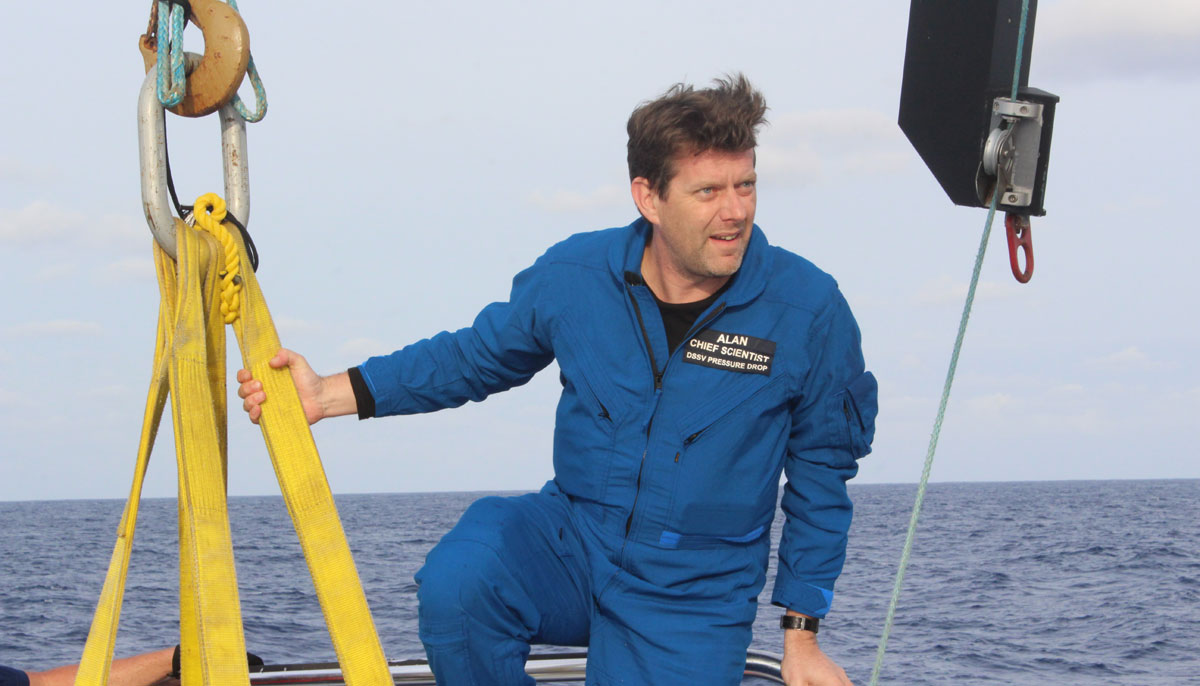Deep sea scientist breaks British depth record
Published on: 17 April 2019
Newcastle University scientist plunges 7,180 metres into the depths of the Java Trench to become the deepest diving Brit in history.

Dr Alan Jamieson, Chief Scientist on the Five Deeps Expedition and a senior lecturer at Newcastle University, UK, was part of the team to reach one of the most isolated points on the planet: the deepest point of the Java Trench in the Indian Ocean.
Led by deep sea pioneer Victor Vescovo, the team travelled 23,596 feet to the bottom of the trench and captured footage of what are believed to be entirely new species, yet unseen by humans. This included a new species of hadal snailfish and an extraordinary gelatinous animal – thought to be a Stalked Ascidean, otherwise known as a Sea Squirt – which does not resemble anything seen before.
This is the third time the Five Deeps team has successfully dived to the previously-unvisited bottom of one of the world’s five oceans.
Spending an incredible 8 hours underwater - 2.5 hours down, 3 hours on the bottom and 2.5 hours to return safely to the surface - the team the mission is being filmed by Atlantic Productions for a five-part Discovery Channel documentary. The series is due to air in late 2019.
"Significant moment"
Dr Jamieson, a senior lecturer in marine ecology, said:
“It is not often we see something that is so extraordinary that it leaves us speechless.
“Amongst many other rare and unique observations, the stalked Ascidean was a really significant moment. At this point we are not entirely sure what species it was, but we will find out in due course.
“This was a big moment for hadal science and really demonstrated the scientific capability of the submersible.
“It has now proven that we can now do more, and access more places, than with any other marine vehicle in the world – including remotely-operated vehicles – at these extreme depths.”
Newcastle University scientists and engineers have been pioneering technology for the exploration of these ultra-deep environments for the last five years and have to date completed more than 250 deployments of their novel ‘lander’ systems.
Using two full-ocean depth (11,000 m) capable landers equipped with HD cameras and traps the Newcastle team have been able to explore the deep sea, discovering three new species of Snailfish in the Atacama Trench.The team also discovered the first evidence of man-made fibres and plastic in the guts of crustaceans taken from Challenger Deep in the Mariana Trench - some of the deepest living organisms on earth.
Five Deeps Expedition
The Five Deeps Expedition is the first oceanic journey to take a manned, commercially-certified submersible vessel further and deeper than any in history. So far, the expedition has resulted in:
• First descent to the bottom of the Indian Ocean
• The most solo dives - three - deeper than 7,000m have now been made by a single individual, Victor Vescovo
• First manned descent of any significant depth (below 2,000 meters) in the Java Trench and the first descent to the absolute bottom of the trench (7,192m)
• Deepest dive by a British citizen (Scottish) in that country’s history, by Dr. Alan Jamieson to 7,180 meters, and first to visit a hadal zone
• First seabed lander operations including biological sampling and depth confirmation at the bottom of the Diamantina Fracture Zone in the Indian Ocean, 800 miles west of the Australian coast
• Discovered at least 4 new species of life, including one significantly-sized, stalked Ascidean, previously unseen by any member of the expedition science team
• Completed the third dive of the Five Deeps Expedition and thus 60% complete with the overall mission, and remaining on schedule for completion in September 2019
“Among other things, the Five Deeps Expedition has finally settled the debate about where the deepest point in the Indian Ocean is,” says Vescovo.
“Our Kongsberg EM124 multibeam sonar – the most advanced sonar currently mounted on a civilian vessel – provided detailed maps of the Diamantina Fracture Zone sea floor off the coast of Australia, as well as the deepest parts of the Java Trench.
“Together with physical visitation from unmanned landers and the DSV Limiting Factor submersible, we believe we have built the most precise maps possible of the deepest places in the Indian Ocean.
“The deepest point is in the central part of the Java Trench – not the east as was widely assumed - and that’s exactly where we dove.”



